Traffic Analytics

What is a modern Traffic Analytics system?
Traffic analytics is a blend of computer vision, neural networks, and analytics dashboards that convert video or sensor input into counts, classifications, flows, and alerts. In short: cameras/sensors → AI → dashboards & alerts.
- Video + AI (people counting foot traffic analytics / traffic counting video analytics software) detects and classifies humans and vehicles.
- Sensor fusion (radar, thermal, infrared) improves accuracy in low light or dense crowds.
- Cloud or edge analytics turn raw counts into historical trends, heatmaps, and KPIs.
After putting it to the test, we found that video systems powered by modern neural networks outperform simple threshold detectors in complex environments like multi-entrance malls.
Neural-network backbone
The module works on the basis of neural networks for robust detection even in cluttered scenes.
High-accuracy vehicle classification
Passenger car, truck, bus — the system distinguishes classes for better incident triage and reporting.
Real-time statistics
Vehicles and people real time traffic statistics feed dashboards for immediate action.
- 01 Incident detection — automatically recognize accidents, congestion, and abnormal traffic behavior
- 02 Scalable architecture — flexible deployment from single sites to nationwide smart city networks
- 03 Cloud & edge analytics — choose local processing for speed or cloud for long-term insights
- 04 Seamless VMS integration — easy integration with existing video management systems
- 05 Actionable reports — export traffic statistics into PDF, Excel, or live dashboards
- 06 Multi-environment robustness — reliable performance across day/night, weather, and crowded conditions
Comparison of traffic analytics types
Approach |
Data Source |
Best for |
Pros |
Cons |
|---|---|---|---|---|
|
Video-based (camera + AI) |
IP Cameras |
Mixed vehicle + pedestrian sites (malls, roads) |
Rich visual data, classification by object type, flexible |
Needs good angles & lighting; privacy concerns need managing. |
|
Dedicated sensors (radar/thermal/door counters) |
Radar, thermal, beam counters |
Workplaces, small stores, entrances |
Highly accurate for counts, privacy-friendly |
Less context (no classification), limited situational awareness. |
|
Location analytics (mobile data panels) |
Mobile-device location panels |
Macro footfall trends across regions |
Great for competitive benchmarking and catchment analysis |
Sample-based (not 100% coverage), privacy & data-sampling caveats. |
How Traffic Analytics System Works
01
Ingest: The system receives and consolidates data streams from city cameras, on-site CCTV, and IoT sensors (IP cameras, edge devices). It supports multiple formats and protocols simultaneously, ensuring that both live video and metadata are captured without delays.
02
Detect & Classify: Neural networks detect objects, classify vehicle types, and count people as they move in/out. When we trialed this product, we used a mix of camera angles and camera heights for best accuracy. Our team discovered through using this product that camera placement matters as much as the algorithm.
03
Aggregate & Act: Statistics are formed and presented in dashboards; alerts are triggered for incidents, congestion, or crowding. Based on our firsthand experience, short daily reports and live alerts are the features operations teams use most.
Implementation checklist — how to deploy traffic analytics
- Define KPIs — foot traffic, dwell time, vehicle classes, incidents per month.
- Survey cameras & sensors — map angles, heights, and fields of view. Through our trial and error, we discovered that camera height and entrance coverage dramatically affect accuracy.
- Decide core data source — video, sensors, or hybrid.
- Plan privacy & compliance — anonymization, retention policies, signage.
- Pilot & validate — run a two-week audit against manual counts. Our analysis of this product revealed that a short audit catches most misconfigurations.
- Integrate dashboards — feed analytics into daily ops and incident alerts.
- Scale — roll out cameras, calibrate zones, and set automated reporting.
FAQs
The system uses neural networks to detect and classify objects from video feeds, generating accurate statistics on traffic flow and pedestrian activity.
Traffic analytics is widely used in smart cities, transportation, retail, education, industry, and private property security.
Real-time analytics helps prevent accidents, optimize traffic flow, and improve safety in both urban and private environments.